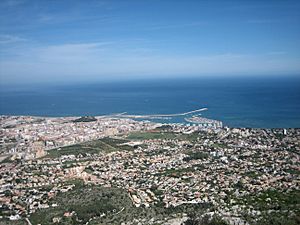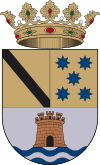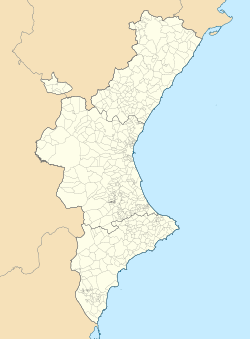Dénia facts for kids
Quick facts for kids
Dénia
|
|||
|---|---|---|---|
| Dénia (official) | |||

View of Dénia from the Montgó out to sea
|
|||
|
|||
| Country | |||
| Autonomous community | |||
| Province | Alicante | ||
| Comarca | Marina Alta | ||
| Judicial district | Dénia | ||
| Area | |||
| • Total | 66.2 km2 (25.6 sq mi) | ||
| Elevation | 22 m (72 ft) | ||
| Population
(2018)
|
|||
| • Total | 41,733 | ||
| • Density | 630.4/km2 (1,632.7/sq mi) | ||
| Demonym(s) | denier(a) (va) dianense (es) |
||
| Time zone | UTC+1 (CET) | ||
| • Summer (DST) | UTC+2 (CEST) | ||
| Postal code |
03700
|
||
Dénia is a historic city on the coast of Spain. It is located in the province of Alicante, on the Costa Blanca. Dénia is about halfway between the cities of Alicante and Valencia. It is the main city and judicial center of the comarca called Marina Alta.
Dénia's long history has been shaped by many different cultures. These include the Iberians, Greeks, Romans, and Islamic people. Later, Napoleonic and Christian influences also played a part. As of 2024, about 49,700 people live in Dénia. However, this number more than doubles during the summer because of tourism.
Contents
A Look at Dénia's Past
Early Settlements and Roman Times
People have lived in the Dénia area since very old times. You can still find important ruins from the Iberian people on nearby hills. Around 400 BC, Dénia was a Greek colony. It might have been a place called Hēmeroskopeion, which means "watchtower."
Dénia was a friend to Rome during the Punic Wars. Later, it became part of the Roman Empire. The Romans called it Dianium, after their goddess Diana. In the 1st century BC, a Roman leader named Quintus Sertorius even set up a naval base here.
From Visigoths to Muslim Rule
From 636 to 696 AD, Dénia was a religious center under Visigothic rule. It had a bishop who reported to Toledo. After the Muslims took over Spain, Dénia became the capital of its own small kingdom. This kingdom was called a Taifa. It ruled parts of the Valencian coast and the island of Ibiza.
Muslim leaders from Slavic backgrounds, called saqālibah, took control of Dénia. They even expanded their kingdom to include Majorca. But in 1076, the Taifa of Dénia lost its independence. It was taken over by the ruler of Zaragoza. Later, in 1091, the Almoravids invaded. The original castle fortress was built by the Muslim Arabs. The French, who occupied the city in the early 1800s, rebuilt it.
Christian Reconquest and Later History
Christians took Dénia back in 1244. This caused the city to decline, and many Muslim residents left. The government of Valencia later helped people move back. In 1298, Dénia became a special area called a fief. It was controlled by the de Sandoval family from 1431. However, the city itself returned to the Aragonese crown in 1455.
Dénia became a marquisate in 1487. It gained many special rights thanks to Francisco Gómez de Sandoval y Rojas, Duke of Lerma. He was a favorite of King Philip III of Spain. The city faced another difficult time in 1609. This was when 25,000 people, called Moriscos, were forced to leave. This greatly harmed the local economy.
During the War of the Spanish Succession in 1707, French troops attacked Dénia. They broke down parts of the city walls. But the small group of defenders fought back bravely. The French had to stop their attack after 27 days. However, Dénia did fall to the French later that year. In 1713, a peace treaty returned Dénia to Spanish rule.
In 1803, Dénia became part of the Spanish crown again. After this, it grew into an important trading port. Many English traders lived in Dénia from the 1800s until the Spanish Civil War in the late 1930s.
What to See in Dénia
Dénia is famous for its large Moorish castle. It's called Castle of Dénia and sits on a rocky hill overlooking the city. The castle was built in the 11th and 12th centuries. From there, you can see amazing views of the sea, the city, and the area around it. Inside the castle, you'll find the Palau del Governador and a museum.
Dénia also has the Museu Etnològic. This museum shares more about the city's history and culture.
Dénia's Weather
Dénia has a Mediterranean climate. This means it has mild winters and hot summers. The average temperature each year is above 18°C (64°F). The city gets about 750 mm (30 inches) of rain each year.
The coldest month is January, with an average temperature of about 12°C (54°F). The hottest month is August, with an average of about 26°C (79°F). Autumn is the wettest season. It gets over 300 mm (12 inches) of rain. This rain often falls in just a few days, with very heavy downpours. This is a common event in Spain called a cold drop. Both September and October get over 100 mm (4 inches) of rain. November also gets close to 100 mm.
Summer is the driest season, but it still gets some rain. On average, it receives about 70 to 80 mm (2.8 to 3.1 inches). July is the driest month, with less than 5 mm (0.2 inches) of rain. It is also the sunniest month. Storms are common in autumn, with about 15 stormy days each year. Dénia enjoys about 2750 hours of sunshine every year.
| Climate data for Dénia, Spain | |||||||||||||
|---|---|---|---|---|---|---|---|---|---|---|---|---|---|
| Month | Jan | Feb | Mar | Apr | May | Jun | Jul | Aug | Sep | Oct | Nov | Dec | Year |
| Mean daily maximum °C (°F) | 17 (63) |
17 (63) |
19 (66) |
21 (70) |
24 (75) |
28 (82) |
30 (86) |
31 (88) |
29 (84) |
25 (77) |
20 (68) |
18 (64) |
23 (74) |
| Mean daily minimum °C (°F) | 7 (45) |
8 (46) |
9 (48) |
11 (52) |
14 (57) |
18 (64) |
21 (70) |
22 (72) |
19 (66) |
15 (59) |
10 (50) |
8 (46) |
14 (56) |
| Source: Weather2 | |||||||||||||
Getting Around Dénia
You can take a ferry from Dénia to Ibiza and other Balearic Islands every day. The city is also the end point for a railway line. This line goes through the mountains from Alicante. It's often called the Limón Express. This train is not just for tourists. It runs all year and is used by people commuting.
Dénia's Culture and Traditions
Festivals
The bonfire festival is a big celebration in Dénia every March. Huge statues made of papier-mâché, called fallas, are set up all over town. Then, they are set on fire in a spectacular display.
Another exciting festival is the Bous a la Mar. This means "Bulls at the Sea" and happens in July. The main event of this week-long festival is watching bulls run down the main street, Marqués de Campo. Then, brave people chase them into a temporary bullring in the Mediterranean Sea.
Art and Food
Since 1974, Dénia has been home to the famous painter and sculptor Joan Castejón. The town honored him in 1999, calling him an Adoptive Son of Dénia.
In 2015, Dénia was named an UNESCO Creative City of Gastronomy. This means it's recognized for its amazing food culture. The famous Chef Quique Dacosta has a restaurant in Dénia. It has three Michelin stars, which is a very high honor for a restaurant.
Famous People from Dénia
- Abu al-Salt, a smart person who knew many subjects
- Joan Castejón, a sculptor
- Marta García, a racing driver
- Alberto Sols García, a biochemist
- Pepelu a footballer who plays for Valencia CF
Sports in Dénia
Dénia's local football (soccer) team is called Club Deportivo Dénia. They play in Spain's Third Division.
Sister Cities
Dénia has a sister city:
 Cholet, France
Cholet, France
Images for kids
-
1609 Expulsion of the Moriscos at the port of Dénia, by Vincente Mostre
See also
 In Spanish: Denia para niños
In Spanish: Denia para niños








